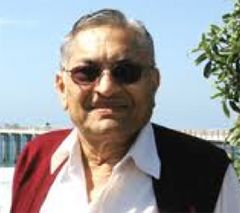Devendra Lal facts for kids
Quick facts for kids
Devendra Lal
|
|
|---|---|
 |
|
| Born | 14 February 1929 Varanasi, India
|
| Died | 1 December 2012 (aged 83) La Jolla, California, United States
|
| Nationality | Indian |
| Alma mater |
|
| Spouse(s) | Aruna Lal (née Damany) |
| Awards |
|
| Scientific career | |
| Fields | Geophysics |
| Institutions |
|
| Thesis | (1960) |
| Academic advisors | Bernard Peters |
Devendra Lal (born February 14, 1929 – died December 1, 2012) was an important Indian scientist. He was a geophysicist. This means he studied the Earth's physical processes. He looked at things like rocks, oceans, and even space particles.
About Devendra Lal
Devendra Lal was born in Varanasi, India. He went to Banaras Hindu University for his studies. Later, he also studied at Bombay University. His special project there was about cosmic ray physics. Cosmic rays are tiny, high-energy particles from space. His teacher for this project was Bernard Peters.
His Scientific Career
Devendra Lal held many important jobs. From 1972 to 1983, he was the Director of the Physical Research Laboratory in Ahmedabad, India. This is a big science center.
Later, he became a Visiting Professor. He worked at the Scripps Institution of Oceanography. This is part of the University of California, San Diego. He taught there from 1989 until 2012.
Leadership in Science
Devendra Lal was also a leader in the global science community. He was the President of the International Union of Geodesy and Geophysics (IUGG). He held this role from 1983 to 1987. The IUGG is an organization that brings together scientists who study the Earth.
In 1979, he was chosen as a Fellow of the Royal Society. This is a very high honor for scientists. It means he was recognized for his important contributions to science.
Awards and Honors
Devendra Lal received many awards for his work. Some of these include:
- The Shanti Swarup Bhatnagar Prize for Science and Technology in 1967.
- The Krishnan Medal from the Indian Geophysical Union in 1965.
- He became a Fellow of the Indian National Science Academy in 1972.
- He was also a Foreign Associate of the National Academy of Sciences in 1975.
- In 1997, he received the V.M. Goldschmidt Medal. This is a major award in the field of geochemistry.
- He was awarded the Padma Shri in 1971. This is one of India's highest civilian honors.

